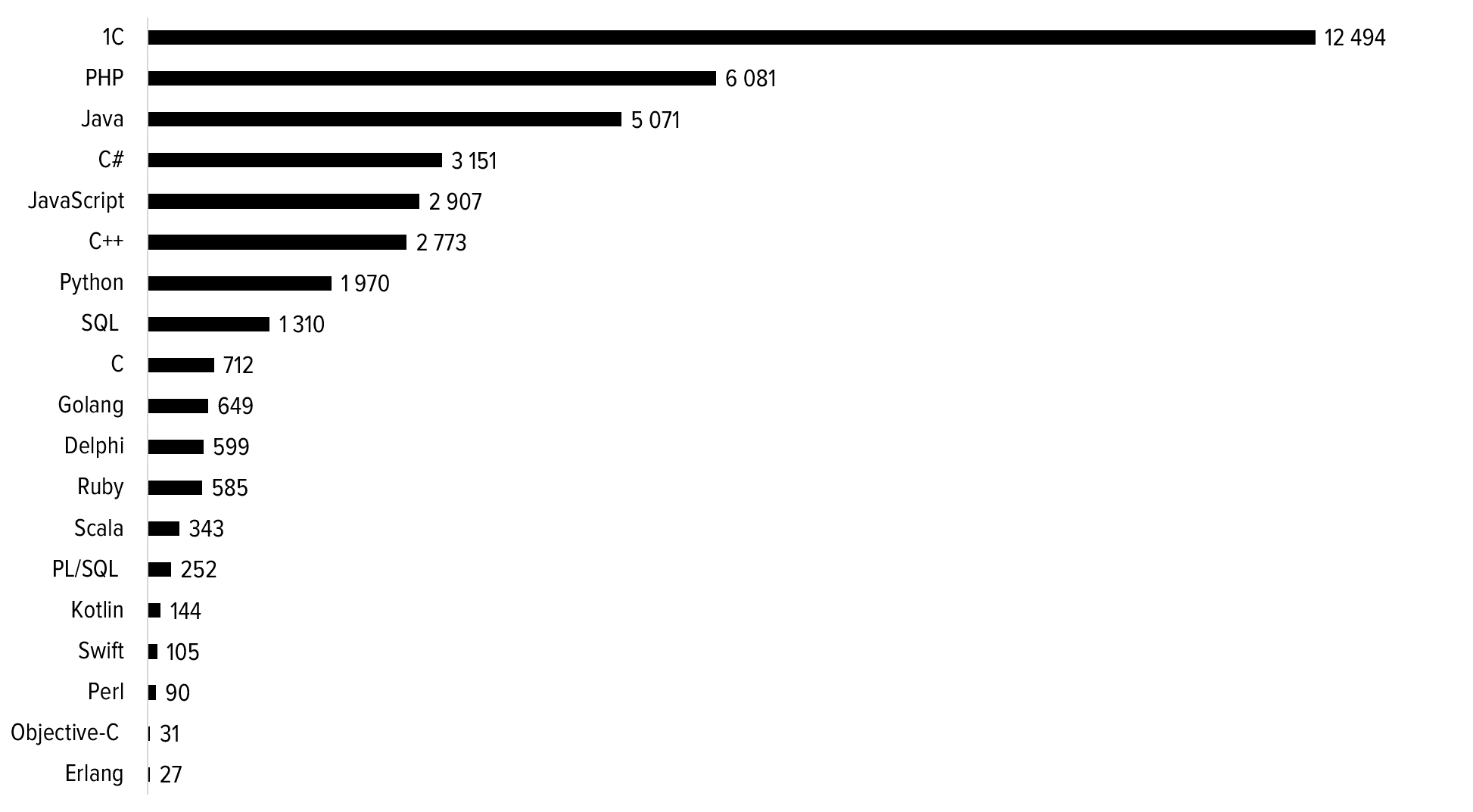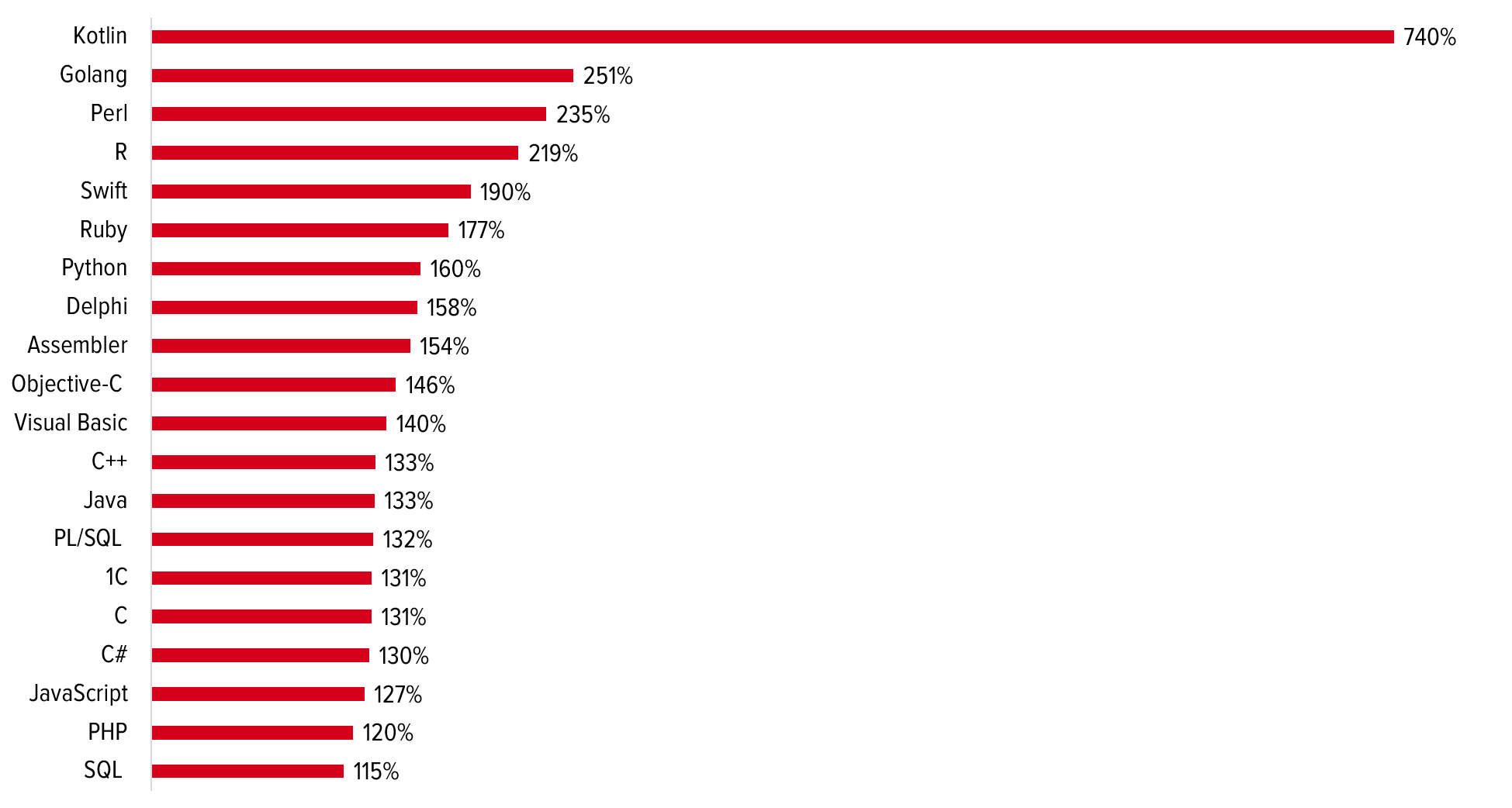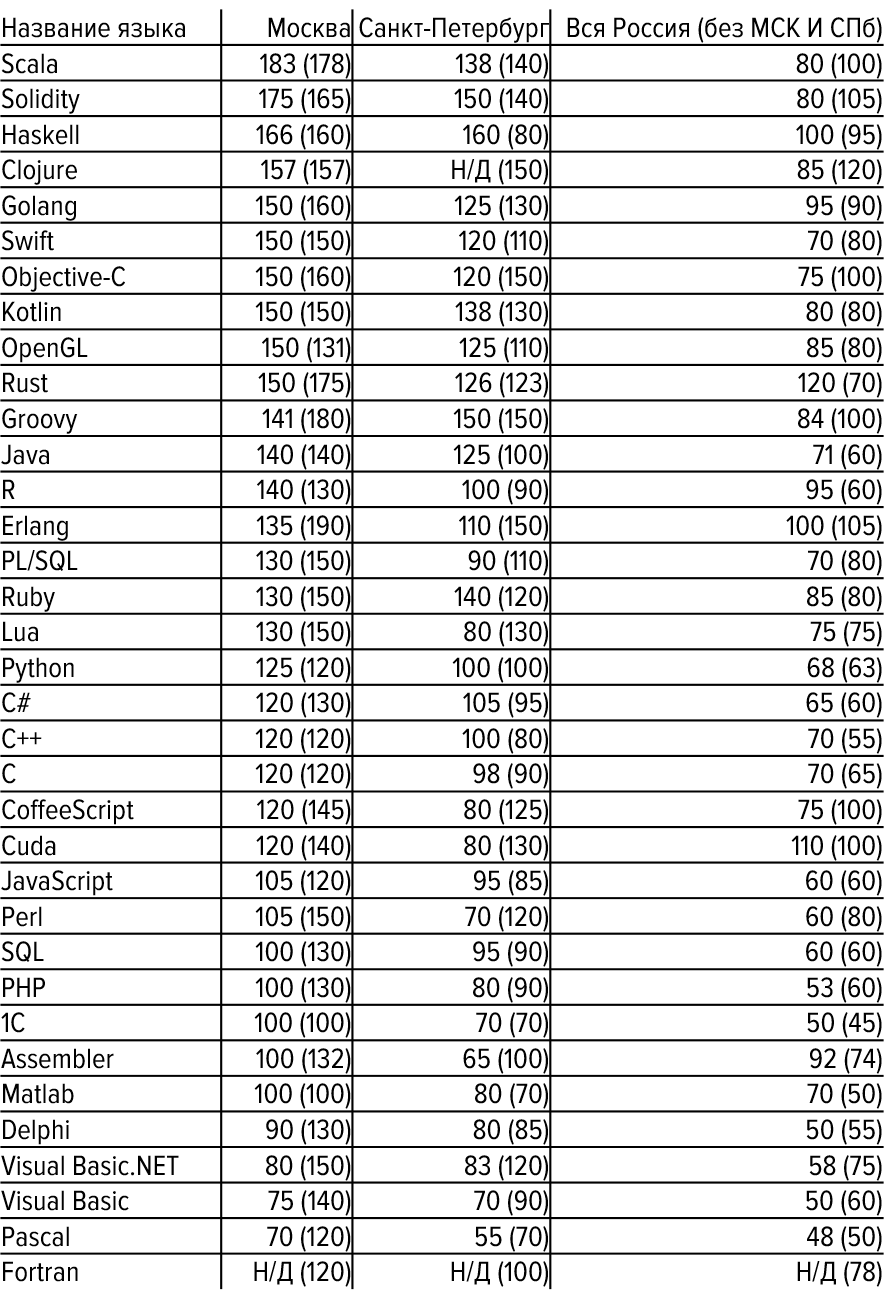The most popular programming languages - 2018
The next statistics from hh.ru under the cut. In short, I really wanted to count in which languages the domestic developers most often write and which languages are most often searched by employers. Total - considered that indicated in vacancies and resumes in the first half of 2018 and 2017. It turned out what happened.

How it was. First, the list of languages - logic-intuitively assembled n languages, removed pieces of the type TypeScript, React, CSS, and so on. Mentally ready for a holivaru on the topic of the absence of Cobolʻa or something else (when making the list, I could have missed something, but missed something).
')
1. When the name of a language is found anywhere in a job, be it a description, a name or requirements. Job example:
Such a vacancy will be taken into account in both Java and Python statistics.
2. When the name of the language is found only in the title of the vacancy. This means that the vacancy from the example above will be taken into account only in Java statistics. All this is needed in order to roughly separate core subj from related skills and to better understand what is on the market).
In the case of such languages as, for example, 1C or Assembly, I searched for the names of the language along with the words developer or engineer or synonyms.
A few more important notes:
As I wrote above, the number of vacancies in JavaScript can take into account vacancies with names like “Python-developer”, if JS is mentioned somewhere in the body of such vacancies. JS and SQL in the statistics below are absolute leaders, since they are often indicated by others in addition with the “plus will be” mark. By the way, the languages here are not all from the list - for example, Solidity: a new thing for the block and smart contracts, only 160 vacancies in the first half of 2018 (wages will be lower, there will be statistics on it).

Of course, we don’t have the rule “if you’re looking for a Java developer, write the name in the title,” so you cannot say that everything is there (i.e. there are no vacancies with the name “Senior backend developer” in this statistics at all). Total: 1C leader, second PHP (specificity of the domestic market?), Java next (Java job market is described here ).

The ratio of the number of vacancies from the first schedule (where the language was searched throughout the vacancy) to the first half of 2017 (the same period, the same search algorithm). It turned out that the demand for those who know in Kotlin increased by 7 times, and there will be more.

Important: resume! = Person, because everyone has the opportunity to create multiple resumes within the same applicant. However, about 100k applicants know SQL (well), as many know 1C (only those who call themselves programmers are taken into account). A curious example: for two thousand vacancies with golang there are eight thousand developers.

Now only those resumes where the language is indicated in the title. 1C is again the leader, SQL is only the eighth (most often the main one is not, which can also be said about vb, R and, possibly, JS). PHP is not a leader (they don’t like to write about it in the title of a resume, apparently).

Further two tables. With all the dislike for the tables, I don’t see any other way to show salaries. So, proposed (from vacancies) - without brackets, and expected (from resume) in brackets. Values in thousands of rubles, median. Sorted in descending order. Scala, Solidity and Haskell absolute leaders in the proposed sn. At clojure in Petersburg and at fortran, “N / A” is everywhere indicated, which means that thirty vacancies (at least for analysis) with the specified salary were not found for them in 2018.

It is interesting here. The proportion of the total number is shown - for example, Moscow accounts for 41% of the total number of vacancies in Java and 39% of the resume (in brackets). Also sorted by descending proportion of Moscow.

That's all. Questions are welcome. Thank!
UPD: the number of vacancies was updated with mention of the 1C language.

How it was. First, the list of languages - logic-intuitively assembled n languages, removed pieces of the type TypeScript, React, CSS, and so on. Mentally ready for a holivaru on the topic of the absence of Cobolʻa or something else (when making the list, I could have missed something, but missed something).
list
Then I searched for the words on the list in the vacancies (the algorithm is similar when calculating the resume). Divided the search into two parts:1C
Assembler
C
C #
C ++
Clojure
CoffeeScript
Cuda
Delphi
Erlang
Fortran
Golang
Groovy
Haskell
Java
Javascript
Kotlin
Lisp
Lua
Matlab
Objective c
Opengl
Pascal
Perl
Php
PL / SQL
Prolog
Python
R
Ruby
Rusty
Scala
Solidity
SQL
Swift
Visual basic
Visual Basic .NET
Assembler
C
C #
C ++
Clojure
CoffeeScript
Cuda
Delphi
Erlang
Fortran
Golang
Groovy
Haskell
Java
Javascript
Kotlin
Lisp
Lua
Matlab
Objective c
Opengl
Pascal
Perl
Php
PL / SQL
Prolog
Python
R
Ruby
Rusty
Scala
Solidity
SQL
Swift
Visual basic
Visual Basic .NET
')
1. When the name of a language is found anywhere in a job, be it a description, a name or requirements. Job example:
Name: Java Developer
Description: ... welcome knowledge of scripting languages, for example, Python ...
Such a vacancy will be taken into account in both Java and Python statistics.
2. When the name of the language is found only in the title of the vacancy. This means that the vacancy from the example above will be taken into account only in Java statistics. All this is needed in order to roughly separate core subj from related skills and to better understand what is on the market).
In the case of such languages as, for example, 1C or Assembly, I searched for the names of the language along with the words developer or engineer or synonyms.
A few more important notes:
- period: the first half of 2018 (01/01/2018 - 06/30/2018),
- compared with the same period in 2017,
- I searched all over Russia without being tied to cities,
- archival and hidden vacancies and resumes taken into account.
Top 20 languages by the number of vacancies (mention in any paragraph of the vacancy)
As I wrote above, the number of vacancies in JavaScript can take into account vacancies with names like “Python-developer”, if JS is mentioned somewhere in the body of such vacancies. JS and SQL in the statistics below are absolute leaders, since they are often indicated by others in addition with the “plus will be” mark. By the way, the languages here are not all from the list - for example, Solidity: a new thing for the block and smart contracts, only 160 vacancies in the first half of 2018 (wages will be lower, there will be statistics on it).

Top 20 languages by the number of vacancies (mentioned in the title)
Of course, we don’t have the rule “if you’re looking for a Java developer, write the name in the title,” so you cannot say that everything is there (i.e. there are no vacancies with the name “Senior backend developer” in this statistics at all). Total: 1C leader, second PHP (specificity of the domestic market?), Java next (Java job market is described here ).

Change in the number of vacancies in relation to the previous year
The ratio of the number of vacancies from the first schedule (where the language was searched throughout the vacancy) to the first half of 2017 (the same period, the same search algorithm). It turned out that the demand for those who know in Kotlin increased by 7 times, and there will be more.

Top 20 languages by number of summaries (mention in any paragraph of the summary)
Important: resume! = Person, because everyone has the opportunity to create multiple resumes within the same applicant. However, about 100k applicants know SQL (well), as many know 1C (only those who call themselves programmers are taken into account). A curious example: for two thousand vacancies with golang there are eight thousand developers.

Top 20 programming languages by number of resumes (mention in the title of the resume)
Now only those resumes where the language is indicated in the title. 1C is again the leader, SQL is only the eighth (most often the main one is not, which can also be said about vb, R and, possibly, JS). PHP is not a leader (they don’t like to write about it in the title of a resume, apparently).

Salaries descending
Further two tables. With all the dislike for the tables, I don’t see any other way to show salaries. So, proposed (from vacancies) - without brackets, and expected (from resume) in brackets. Values in thousands of rubles, median. Sorted in descending order. Scala, Solidity and Haskell absolute leaders in the proposed sn. At clojure in Petersburg and at fortran, “N / A” is everywhere indicated, which means that thirty vacancies (at least for analysis) with the specified salary were not found for them in 2018.

Share of vacancies and resumes in Russia
It is interesting here. The proportion of the total number is shown - for example, Moscow accounts for 41% of the total number of vacancies in Java and 39% of the resume (in brackets). Also sorted by descending proportion of Moscow.

That's all. Questions are welcome. Thank!
UPD: the number of vacancies was updated with mention of the 1C language.
Source: https://habr.com/ru/post/418079/
All Articles